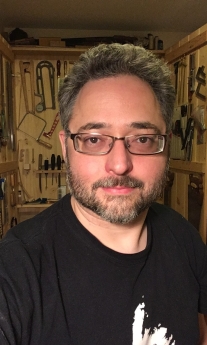About Stephen
This website is a resource site for violin making and blog for Stephen Churchill’s violin making activities.
My Interest in Violin Making

I’ve always been interested in listening-to, making and exploring music of all types. I first became interested in violin making when my great-grandfather’s violin was discovered in my grandmother’s attic. She had never played it and he had died at a fairly young age. The violin had some water damage, and was missing many parts. Seizing on the opportunity to restore a family heirloom, I decided to see if I could have it repaired.
initially I took it to the local music shop. A small shop in the downtown of the small town where I lived at the time, and run by a nice enough fellow. I unwrapped the priceless treasure from the blanket I transported it in and showed it to the owner. He looked over my great-grandfather’s violin, in its rather poor condition, and said ‘I usually turn these into clocks, there’s one in the window’. I doubt I successfully hid my horror with the idea. The second choice was an amateur luther living just outside the city. I bought the required parts (tailpiece, fingerboard, button, bridge, and strings) and brought the lot to him. The result was amazing.
What I learned from that experience was that these instruments, made in the traditional way, can live more than generations, they can live centuries at least. I cam e to realize that making such instruments was the culmination of my interest in arts, creativity, and music, combined into a single beautiful and functional object. What I can’t imagine is why anyone who could, wouldn’t want to make such musical instruments!
Bio
Stephen is originally from Newfoundland and Labrador and currently resides near Vancouver, British Columbia. At a young age he began piano lessons and later played trumpet in a community band that played community festivals and centers around Newfoundland. He is currently an amateur violin player.
Stephen has been an avid woodworker since childhood and most active since 2001. He made his first instrument in 2007, a process that took a year and was done under the tutelage of a violin and viola maker who had studied at Merton College in London, UK . He has since begun working with local violin makers to improve his works.
Stephen’s educational background is in engineering; a field in which he has worked and traveled internationally. Stephen started with the Canadian telecommunications giants and moved into the aerospace industry in 2001. In 2012 he moved into the computer chip industry. Stephen holds a Master’s degree from Memorial University of Newfoundland.
Stephen is a member of the Violin Society of America and The Violin Makers Association of British Columbia. You can contact Stephen at Stephen.Churchill@gmail.com.
What is the typical spacing between two pegs on the same side of the pegbox on a baroque-era violin?
Hi Don,
The spacing between pegs didn’t change in the transition from baroque to modern setups. In fact, many violins which were altered still retain their original scrolls and peg boxes. If you have a preferred spacing I would recommend using that.
That being said, looking at a Jacob Stainer 1697 violin with its original baroque neck, peg box, and scroll shows that the distance between the pegs on the left side is almost exactly 40mm. This is taken from a Strad poster, I don’t have a 1697 Stainer 🙂
Many thanks for your quick response.
It is sometimes dark to view others in your mirror. After loosing my parents I drifted for a while searching for myself and my soul. I restored vintage woodworking machines by Oliver and metal working machines such as my monarch 10ee with tubes. That led me back to vintage audio and a discovery of my uncles work as a music teacher and an engineer. I was intimidated by my father’s baby grand steinway in the corner of my living room. I found a text from 1901 on the making of violins including moulds for three very famous violins. As an engineer I always wondered how strad. did what he did… was it varnish or was it more? I could spend hours listening to various classical and cross over pieces while working in my shop. A combination of the old and new… from my own versions of norris infill planes to making tooling for one of only two german shapers of its kind. Mine and the one at the metropolitan museum of art in new york. Making luther tools of brass, stainless and rosewood infill… I have found the world of the luther to be soul quieting… finally a trek has come home.
I would like to know th side height and top and back plate height of the del gesu ll cannone
Hi William. The rib height of the Cannone varies fairly evenly from 33mm at the end pin to 31.3mm at the neck root. The back and belly arching height are 15mm.